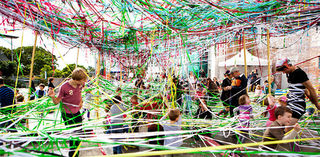Reposted from Psychology Today, April 29, 2019.
You have probably heard of theater for young audiences, but did you know there is a theater for babies? In fact, some of the most experimental and boundary-pushing contemporary live performance around the world is being made for babies, toddlers, and preschoolers.

Artists who make work for this audience embrace the innate imaginative capabilities of childhood, the avant-garde nature of children’s imagination, and children’s developmental differences from adults. Theatre makers and performers engage in natural experimentation as part of their theatrical creation process — figuring out what their very young audiences react to, engage with, and enjoy. This is very different from the mainstream mode of creating a work of theater for adults, where a script is written and the performance created behind closed doors until it is complete and ready for audiences to watch and pass judgment.
But, if an audience is pre-verbal, then theater can no longer rely on language or linear narrative as the primary vehicle for storytelling; if an audience is not interested in sitting still, then the work must accommodate spectators that may find the floor as interesting as the performers, and if an audience experiences the world primarily through touch and taste, then the storytelling better include multi-sensory – and washable – elements. Nonlinear, nonverbal narratives, opportunities to move around a performance space, and multi-sensory experiences are just some of the recurring elements found in Theater for the Very Young (TVY), also known as Theater for the Early Years, is made for children from birth to five years old. TVY is not a genre, but rather a constantly evolving umbrella title that defies easy generic categorization and includes a wide range of theater, live performance, dance, installation, and participatory-based work
We believe that this work intersects naturally and easily with the science of developmental psychology, and importantly, that as much as theater makers can learn from developmental psychologists about children’s growing social, emotional, and cognitive abilities, so can developmental psychologists learn from theater makers about the real world capacities and preferences of babies. In the spring of 2017, the two of us, (Thalia Goldstein, then an assistant professor of Psychology at Pace University and Adrienne Kapstein, Assistant Professor of Acting and Ensemble Creation, also at Pace University), were mutually interested in TVY – the practice and artistry of making work for this audience – and the specific demands and needs of this population for which the work is being made. To explore this work from an artistic and scientific perspective, we jointly created an interdisciplinary class for undergraduates at Pace University entitled Developing Wonder: Theater, Psychology, and Children. The course was designed to bring these two fields together with a broad approach to each, covering a survey of exemplary TVY practices and shows, and the breadth and depth of scientific knowledge that Developmental Psychology has built about the earliest years of human development.
We felt a college level course was an ideal place to investigate, elaborate, and deeply explore the theory and philosophy of the ways in which these two disparate but related fields can talk to each other. Adrienne had created work for this audience, but never studied Developmental Psychology; Thalia had attended TVY shows and researches theater but had never thought about the underlying structure of this work’s creation. Students in the course did not yet have experience or expertise with either TVY or with the science of Developmental Psychology and would have a chance to learn the fundamentals of each field. They could determine for themselves how the two fields can be in conversation with each other, and make informed choices about how Developmental Psychology could ultimately inform artistic practice. This current moment is also a particularly exciting time for TVY in the U.S. as there is increasing expansion and recognition among artists, audiences, programmers and presenters. Scientific research in Developmental Psychology is also expanding rapidly, with new methods, techniques, and broader questions involving almost any topic in which students and theater-makers could be interested.
As far as we were aware, this class was the first of its kind internationally. After teaching it for one year to great success, we wrote an article outlining the objectives, curriculum, challenges and successes of the course in the hopes that future educators, psychologists or theater makers might continue to explore this fascinating, vibrant and growing theatrical movement. The course combined readings in Developmental Psychology, video examples of exemplary work for this audience, as well as discussion of the methods, theories, and writings of the artists involved in its creation, workshops with theater makers, and a required field trip to see a live performance of theater for the very young. Students had to write papers on topics in developmental psychology and how they might be explored through theatrical performances, as well as create an actual work of theater for the very young, and discuss what psychological constructs it was based on. Papers and topics in developmental psychology were paired with constructs and shows, to develop ties and connections between the two fields.
In conclusion, we found that students embraced how developmental psychology and theater for the very young can be in conversation with each other, as well as learning basic mechanics behind creating a piece of theater that is adaptive, flexible, and integrates the needs of an audience that is preverbal and cannot follow narratives. Similarly, students learned how to do research in developmental psychology, and how the methods of theater making could help expand and explore our knowledge of children’s capabilities.
For more information on the course, including readings, please see Developing Wonder: Teaching Theatre for the Very Young through Collaboration with Developmental Psychology in Youth Theatre Journal, April, 2019.
Author’s note: This blog was co-written with Adrienne Kapstein, Assistant Professor of Acting and Ensemble Creation, Pace University, and references a new publication, which can be found here.
